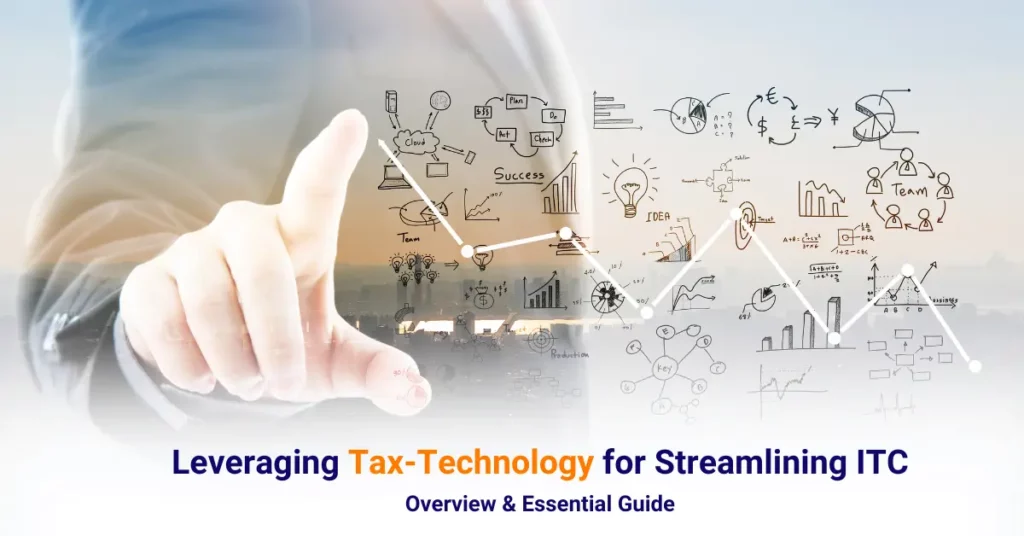Introduction to ITC (Input Tax Credit)
Input Tax Credit (ITC) is like a discount for businesses that pay taxes when they buy things like raw materials or services. Let’s say you run a bakery and you buy flour, paying a tax on it. Later, when you sell cakes and charge tax to your customers, you can subtract the tax you already paid for the flour (ITC) from the tax you collect on selling cakes. This way, you only pay tax on the extra value you added by making the cakes, not on the flour itself. It helps businesses save money and keeps the tax system fairer. So, in this case to avoid a situation where tax is charged on top of tax the ITC was introduced. In this blog we will understand the role of technology in the taxation system and the challenges, regulatory behind implementing technology in the taxation system.
Also Read: What Is Input Tax Credit (ITC)?
The Role of Technology in Taxation
The role of technology in taxation is like having a helpful assistant for businesses and governments. Technologies like artificial intelligence, machine learning, automation, and specialized software play a crucial role in managing tax-related processes.
By applying the technology we can do various things such as:
Efficient Calculations: Technology, like special software and computers, helps with quick and accurate tax calculations, saving time and reducing errors.
- Organized Records: Technology allows for better organization of tax records. Instead of piles of papers, everything can be stored digitally, making it easy to find what’s needed.
- Deadline Reminders: With technology, businesses and individuals can receive automatic reminders for tax deadlines, ensuring they don’t miss important dates.
- Error Detection: Technology can spot mistakes or potential fraud in tax returns. This helps in maintaining the integrity of the tax system and ensures everyone pays the right amount of tax.
- Faster Processing: When tax information is submitted electronically, it can be processed much faster by tax authorities, leading to quicker refunds or acknowledgments.
- Accessibility: Online platforms and digital tools make it easier for taxpayers to access their tax information anytime and anywhere, making the process more convenient.
- Reduced Paperwork: Technology enables electronic filing of tax returns, reducing the need for extensive paperwork and making the process more environmentally friendly.
To make it faster and error free technology plays a crucial role in taxation systems.
Also Read: How to Use Technology to Make Tax Compliance Easier?
Understanding Tax-Technology Solutions
Tax-Technology Solutions are like special tools that help with taxes, making things easier for businesses and tax departments. They help in Calculating Taxes, Managing Data, Filing Taxes, Checking Mistakes, Tracking Deductions, Stying update and many more.
In tax-technology solutions there are plenty of software who helps us to manage the tax related things. They come in different types, each serving a specific purpose such as:
Tax Calculation Software: This software is the core of tax-technology solutions. It quickly and accurately calculates how much tax a business owes based on its income, expenses, and other factors. Businesses can input their financial data, and the software does the math, saving time and reducing errors.
- Compliance Management Systems: These systems ensure that businesses are following all the rules and regulations when it comes to taxes. They keep track of tax deadlines, required forms, and changes in tax laws. This helps businesses avoid penalties for non-compliance and stay on the right side of the law.
- Data Analytics Tools for Tax Planning: These tools use advanced data analysis to help businesses plan their taxes more effectively. They can identify trends, predict tax liabilities, and suggest strategies to minimize taxes legally. For example, they might analyze past tax data to find areas where a business can claim more deductions or credits.
The focus of these solutions is on how they simplify complex tax processes and make Efficiency as well as Accuracy.
Leveraging ITC Through Technology

Leveraging ITC through technology means using special tools to make the most out of the tax benefits available such as:
Automated Calculations: Technology helps businesses automatically calculate how much ITC they can claim on their purchases. This saves time and ensures they claim the right amount.
- Real-Time Tracking: With technology, businesses can track their eligible ITC in real-time. They know exactly how much credit they have accumulated and can use it when needed.
- Timely Claims: Technology reminds businesses to claim their ITC on time. This ensures they don’t miss out on getting credit for the taxes they’ve already paid.
- Reduced Errors: Using technology reduces the chances of mistakes when claiming ITC. Computers are good at keeping records accurate and up-to-date.
- Integration with Purchases: Technology can be integrated with purchasing systems. This means when a business buys something and pays tax on it, the technology automatically records it as eligible for ITC.
- Optimizing ITC: Overall, technology helps businesses optimize their ITC benefits. They can save money by claiming all the credits they’re entitled to, making their operations more efficient.
Integration with Accounting Systems: Tax-technology solutions can integrate with a business’s accounting software. This seamless integration means that ITC claims can be automatically calculated and recorded, reducing manual data entry and improving accuracy.
By leveraging the technology in ITC you can manage every tax related things easily and effectively. It ensures you don’t miss out on tax benefits and can save money on their purchases.
Challenges and Solutions in Implementing Tax-Technology
| Challenges | Solutions |
| 1. Initial Costs | – Seek budget-friendly solutions: Look for tax-technology options that fit within the budget constraints of the business. |
| – Consider phased implementation: Roll out the technology in stages to spread out costs over time. | |
| – Look for cost-sharing opportunities: Explore partnerships or shared services to reduce individual costs. | |
| 2. Integration with Systems | – Choose user-friendly systems: Select tax-technology solutions that are easy to integrate with existing systems, reducing compatibility issues. |
| – Ensure compatibility with existing systems: Prioritize solutions that work smoothly with the current software and processes in place. | |
| – Provide staff training for new systems: Offer training sessions to ensure employees are comfortable using the new technology. | |
| 3. Data Security | – Implement robust data protection measures: Utilize encryption, firewalls, and secure servers to safeguard sensitive tax data. |
| – Regularly update security protocols: Stay proactive in updating security measures to address emerging threats. | |
| – Educate staff on data security: Train employees on best practices for handling and protecting tax-related information. | |
| 4. Staff Training | – Offer comprehensive training programs: Develop training materials and workshops to educate staff on how to effectively use the tax-technology solutions. |
| – Provide ongoing support and resources: Offer assistance and resources to address any questions or issues that arise during implementation and beyond. | |
| – Create user-friendly manuals and guides: Develop easy-to-follow guides and manuals to help employees navigate the new technology. | |
| 5. Resistance to Change | – Communicate benefits of new technology: Clearly communicate how the tax-technology solutions will improve efficiency and accuracy, benefiting both the business and employees. |
| – Involve staff in decision-making: Seek input from employees during the selection process to increase buy-in and reduce resistance. | |
| – Address concerns through feedback sessions: Hold regular feedback sessions to address any concerns or challenges faced by employees and adjust implementation strategies accordingly. | |
| 6. Regulatory Compliance | – Stay updated with tax laws and regulations: Regularly monitor and update tax-technology solutions to ensure they comply with changing tax laws. |
| – Ensure tax-technology complies with standards: Verify that the tax-technology meets industry and regulatory standards for data security and tax compliance. | |
| – Conduct regular compliance checks: Implement processes to regularly audit and verify that the tax-technology is meeting regulatory requirements. |
Regulatory Compliance and Tax-Technology
When it comes to taxes, businesses need to follow rules set by the government. Tax-Technology helps with this in a few ways:
- Keeping Up with Laws: Tax laws can change often, but Tax-Technology stays updated. It makes sure businesses are using the latest rules.
- Meeting Standards: Tax-Technology follows the rules and standards set by the government. This ensures that businesses are doing their taxes correctly.
- Easy Checks: Tax-Technology helps with checks to make sure everything is done right. This includes making sure the right forms are filled out and the numbers add up correctly.
- Avoiding Penalties: If businesses don’t follow the rules, they could face penalties or fines. Tax-Technology helps prevent this by making sure all tax processes are in line with regulatory requirements.
- Reducing Risk: Compliance with regulations reduces the risk of legal issues or audits. Tax-Technology ensures that businesses are prepared for any checks or audits that may arise.
In simple words, Regulatory Compliance and Tax-Technology work together to help businesses follow the tax rules. The technology keeps up with changing laws, meets government standards, and makes sure businesses do their taxes correctly.
Conclusion
To sum it up, using tax-technology is like having a helpful assistant for businesses when it comes to Input Tax Credit (ITC) under the GST system. It makes things easier by doing calculations fast, keeping track of ITC in real-time, and generating easy-to-understand reports. Not only does it save time and reduce mistakes, but it also helps with following the rules and being ready for audits. As we move forward with technology, businesses that embrace tax-technology can expect smoother tax processes, less stress, and better use of their ITC benefits. It’s a win-win for businesses and the tax system alike, making everything run more smoothly.
FAQ’s
-
How does technology help in taxes?
Technology makes tax tasks easier by doing calculations quickly and accurately, keeping records organized, and sending reminders for tax deadlines.
-
What are Tax-Technology Solutions?
Tax-Technology Solutions are tools that help with taxes, like software for calculating taxes, managing data, and filing taxes online.
-
How can ITC be leveraged through technology?
Technology helps businesses optimize their Input Tax Credit (ITC) by automating calculations, tracking ITC in real-time, and integrating with purchasing systems.
-
What are the challenges in using tax-technology?
Challenges include initial costs, integrating with existing systems, data security, staff training, and resistance to change.
-
How can businesses overcome challenges in implementing tax-technology?
Solutions include seeking budget-friendly options, choosing user-friendly systems, implementing robust data security measures, providing staff training, and involving employees in decision-making.
-
Why is regulatory compliance important for tax-technology?
Regulatory compliance ensures that tax-technology follows government rules and standards, avoiding penalties and maintaining trust.
-
How does tax-technology help with compliance?
Tax-technology performs automated checks for compliance, keeps up with changing tax laws, and maintains detailed records for audits.
-
Can tax-technology help small businesses with ITC?
Yes, tax-technology is useful for businesses of all sizes, including small businesses. It helps them claim ITC efficiently and accurately.
-
What are the benefits of using tax-technology for ITC?
Benefits include saving time, reducing errors, ensuring accurate ITC claims, and being prepared for audits.
-
Is tax-technology customizable for different industries?
Yes, tax-technology can be customized for various industries, adapting to their specific tax requirements and processes.
